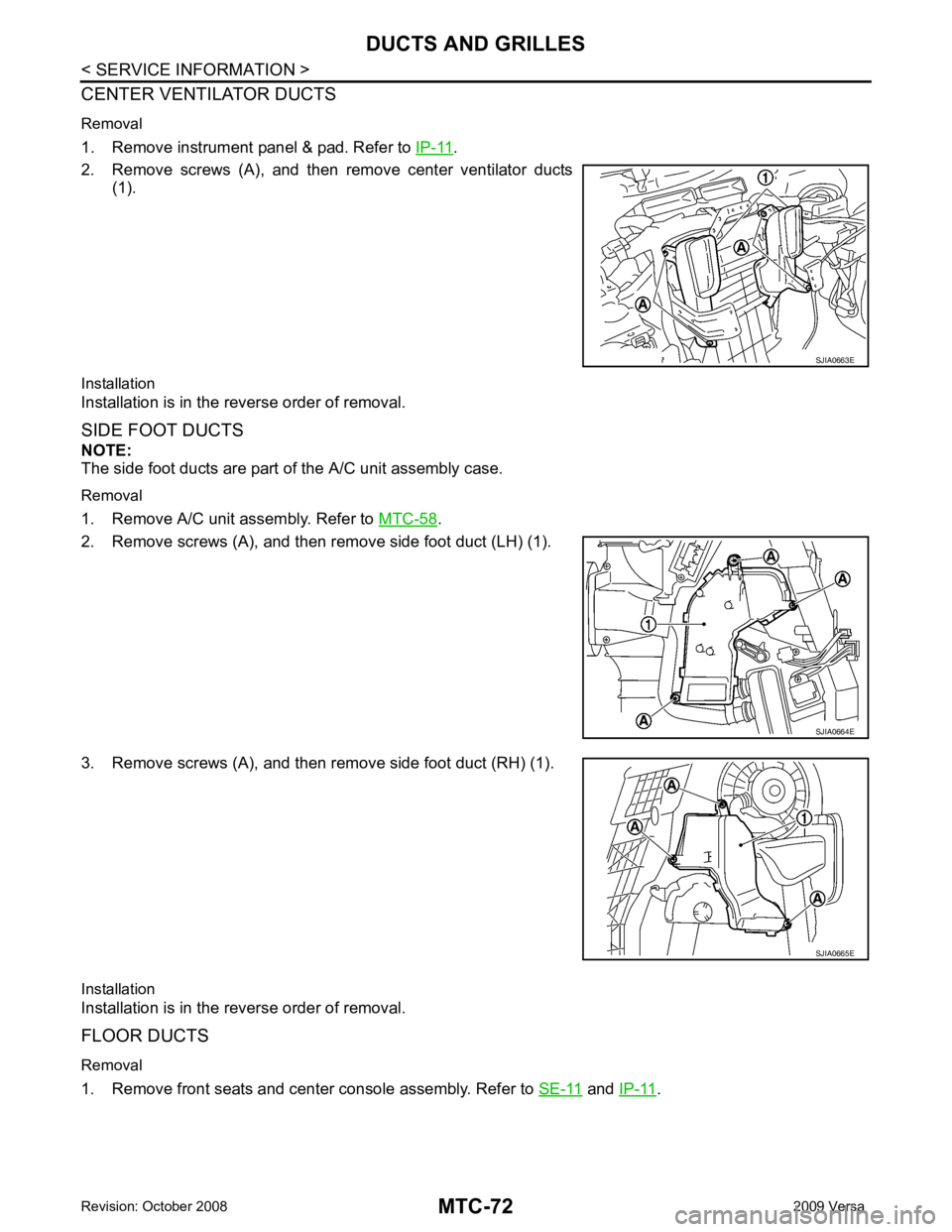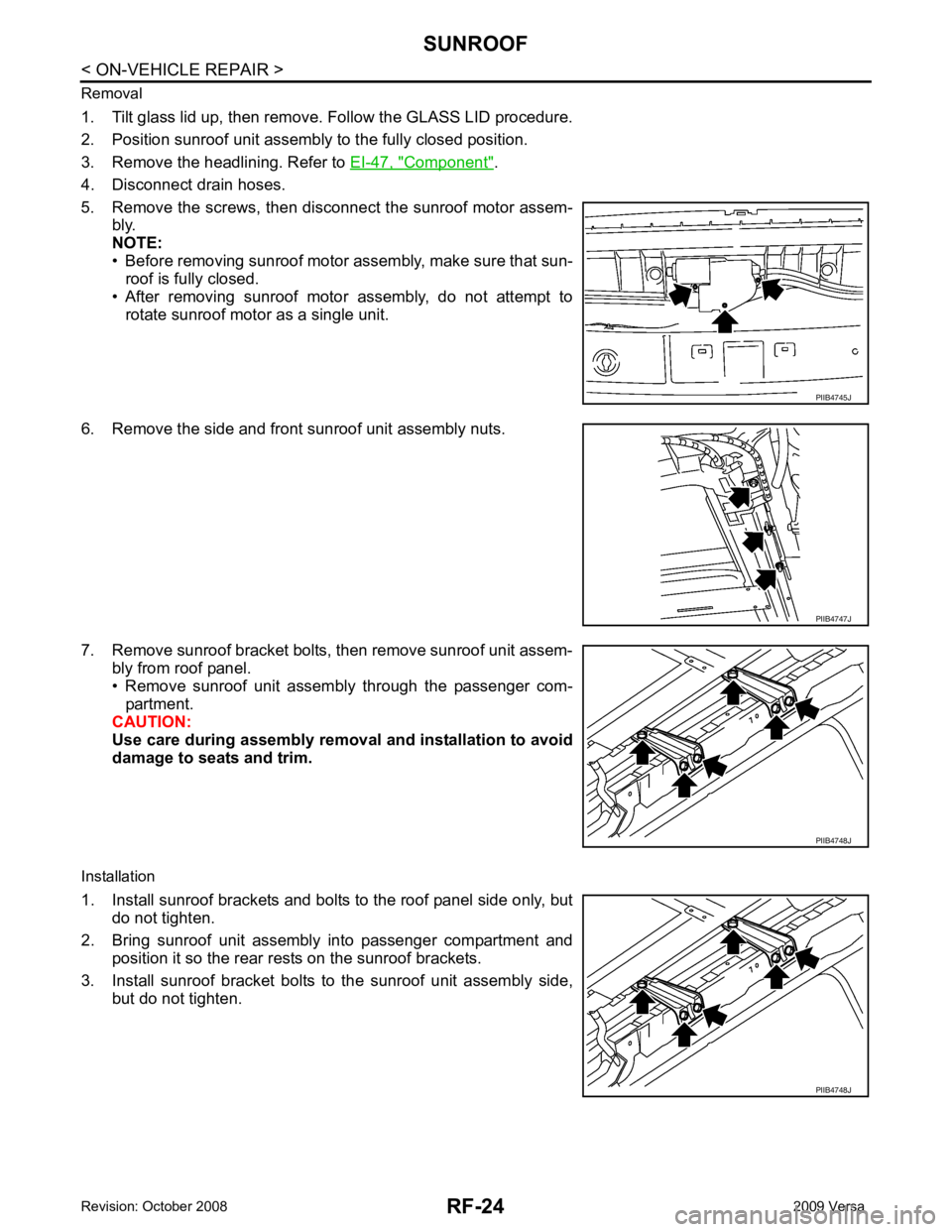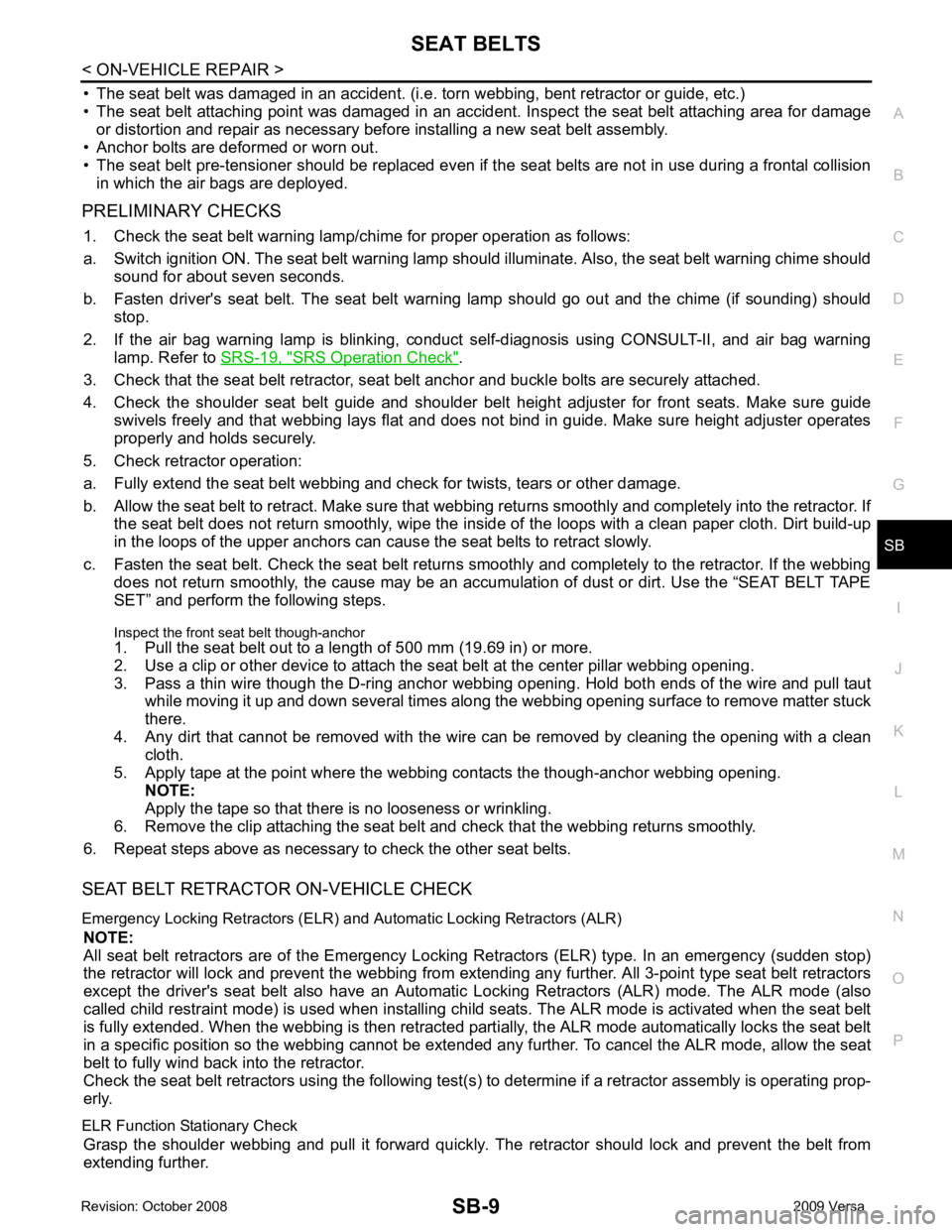2009 NISSAN TIIDA remove seats
[x] Cancel search: remove seatsPage 2124 of 4331
![NISSAN TIIDA 2009 Service Repair Manual EC-768< SERVICE INFOMATION >
[MR TYPE 1]
DTC P0300 - P0304 MULTIPLE CYLINDER
MISFIRE, NO. 1 - 4 CYLINDER MIS-
FIRE
OK or NG OK >> GO TO 7.
NG >> Check ignition coil, power transistor and their circui NISSAN TIIDA 2009 Service Repair Manual EC-768< SERVICE INFOMATION >
[MR TYPE 1]
DTC P0300 - P0304 MULTIPLE CYLINDER
MISFIRE, NO. 1 - 4 CYLINDER MIS-
FIRE
OK or NG OK >> GO TO 7.
NG >> Check ignition coil, power transistor and their circui](/manual-img/5/57398/w960_57398-2123.png)
EC-768< SERVICE INFOMATION >
[MR TYPE 1]
DTC P0300 - P0304 MULTIPLE CYLINDER
MISFIRE, NO. 1 - 4 CYLINDER MIS-
FIRE
OK or NG OK >> GO TO 7.
NG >> Check ignition coil, power transistor and their circuits. Refer to EC-996 .
7.
CHECK SPARK PLUG
Check the initial spark plug for fouling, etc.
OK or NG OK >> Replace spark plug(s) with standard type one(s). For
spark plug type, refer to EM-227, " Standard and Limit " .
NG >> 1. Repair or clean spark plug.
2. GO TO 8. 8.
CHECK FUNCTION OF IGNITION COIL-III
1. Reconnect the initial spark plugs.
2. Crank engine for about three seconds, and recheck whether spark is generated between the spark plug
and the grounded portion.
OK or NG OK >>
INSPECTION END
NG >> Replace spark plug(s) with standard type one(s). For spark plug type, refer to EM-227, " Standard
and Limit " .
9.
CHECK COMPRESSION PRESSURE
Check compression pressure. Refer to EM-185, " On-Vehicle Service " .
OK or NG OK >> GO TO 10.
NG >> Check pistons, piston rings, valves, valve seats and cylinder head gaskets. 10.
CHECK FUEL PRESSURE
1. Install all removed parts.
2. Release fuel pressure to zero. Refer to EC-574, " Fuel Pressure Check " .
3. Install fuel pressure gauge and check fuel pressure. Refer to EC-574, " Fuel Pressure Check " .
OK or NG OK >> GO TO 12.
NG >> GO TO 11. 11.
DETECT MALFUNCTIONING PART
Check the following.
• Fuel pump and circuit (Refer to EC-991 .)
• Fuel pressure regulator (Refer to EC-574, " Fuel Pressure Check " .)
• Fuel lines (Refer to EM-156 .)
• Fuel filter for clogging
>> Repair or replace. 12.
CHECK IGNITION TIMING
Check the following items. Refer to EC-566, " Basic Inspection " .
Spark should be generated.
SEF156I
Spark should be generated.
At idling: Approximately 350 kPa (3.57 kg/cm 2
, 51 psi)
Page 2642 of 4331
![NISSAN TIIDA 2009 Service Repair Manual EC-1286< SERVICE INFOMATION >
[MR TYPE 2]
DTC P0300 - P0304 MULTIPLE CYLINDER
MISFIRE, NO. 1 - 4 CYLINDER MIS-
FIRE
3. Crank engine for about 3 seconds, and recheck whether spark is generated between NISSAN TIIDA 2009 Service Repair Manual EC-1286< SERVICE INFOMATION >
[MR TYPE 2]
DTC P0300 - P0304 MULTIPLE CYLINDER
MISFIRE, NO. 1 - 4 CYLINDER MIS-
FIRE
3. Crank engine for about 3 seconds, and recheck whether spark is generated between](/manual-img/5/57398/w960_57398-2641.png)
EC-1286< SERVICE INFOMATION >
[MR TYPE 2]
DTC P0300 - P0304 MULTIPLE CYLINDER
MISFIRE, NO. 1 - 4 CYLINDER MIS-
FIRE
3. Crank engine for about 3 seconds, and recheck whether spark is generated between the spark plug and the grounded metal portion.
OK or NG OK >> GO TO 7.
NG >> Check ignition coil, power transistor and their circuits. Refer to EC-1518 .
7.
CHECK SPARK PLUG
Check the initial spark plug for fouling, etc.
OK or NG OK >> Replace spark plug(s) with standard type one(s). For
spark plug type, refer to EM-227, " Standard and Limit " .
NG >> 1. Repair or clean spark plug. 2. GO TO 8. 8.
CHECK FUNCTION OF IGNITION COIL-III
1. Reconnect the initial spark plugs.
2. Crank engine for about three seconds, and recheck whether spark is generated between the spark plug
and the grounded portion.
OK or NG OK >>
INSPECTION END
NG >> Replace spark plug(s) with standard type one(s). For spark plug type, refer to EM-227, " Standard
and Limit " .
9.
CHECK COMPRESSION PRESSURE
Check compression pressure. Refer to EM-185, " On-Vehicle Service " .
OK or NG OK >> GO TO 10.
NG >> Check pistons, piston rings, valves, valve seats and cylinder head gaskets. 10.
CHECK FUEL PRESSURE
1. Install all removed parts.
2. Release fuel pressure to zero. Refer to EC-1086, " Fuel Pressure Check " .
3. Install fuel pressure gauge and check fuel pressure. Refer to EC-1086, " Fuel Pressure Check " .
OK or NG OK >> GO TO 12.
NG >> GO TO 11. 11.
DETECT MALFUNCTIONING PART
Check the following.
• Fuel pump and circuit (Refer to EC-1513 .)
• Fuel pressure regulator (Refer to EC-1086, " Fuel Pressure Check " .)
• Fuel lines (Refer to FL-4, " Checking Fuel Line " .)
• Fuel filter for clogging
>> Repair or replace.
Spark should be generated.
SEF156I
Spark should be generated.
At idling: Approximately 350 kPa (3.57 kg/cm 2
, 51 psi)
Page 3140 of 4331
![NISSAN TIIDA 2009 Service Repair Manual CYLINDER HEAD
EM-193
< SERVICE INFORMATION >
[MR18DE] C
D E
F
G H
I
J
K L
M A EM
NP
O
• Check if the contact area band is continuous all around the circum-
ference.
• If not, grind to adjust valve NISSAN TIIDA 2009 Service Repair Manual CYLINDER HEAD
EM-193
< SERVICE INFORMATION >
[MR18DE] C
D E
F
G H
I
J
K L
M A EM
NP
O
• Check if the contact area band is continuous all around the circum-
ference.
• If not, grind to adjust valve](/manual-img/5/57398/w960_57398-3139.png)
CYLINDER HEAD
EM-193
< SERVICE INFORMATION >
[MR18DE] C
D E
F
G H
I
J
K L
M A EM
NP
O
• Check if the contact area band is continuous all around the circum-
ference.
• If not, grind to adjust valve fitti ng and check again. If the contacting
surface still has NG conditions even after the re-check, replace
valve seat.
VALVE SEAT REPLACEMENT When valve seat is removed, replace with oversized [0.5 mm (0.020 in)] valve seat.
1. Bore out old seat until it collapses. Boring shoul d not continue beyond the bottom face of the seat recess
in cylinder head. Set the machine depth stop to ensure this. Refer to EM-227, " Standard and Limit " .
2. Ream cylinder head (1) recess diameter for service valve seat.
• Be sure to ream in circles concentric to the valve guide center.This will enable valve seat to fit correctly.
3. Heat cylinder head to 110 ° to 130 °C (230 ° to 266 °F) by soaking
in heated oil (A).
4. Provide valve seats cooled well with dry ic e. Press-fit valve seat into cylinder head.
WARNING:
• Never touch cold valve seats directly.
• Cylinder head contains heat, wh en working, wear protective equipment to avoid getting burned.
5. Using valve seat cutter set or valve seat grinder, finish valve seat to the specified dimensions. For dimensions, refer to EM-227, " Standard and Limit " .
CAUTION:
When using valve seat cutter, firmly grip the cutter handle
with both hands. Then, press on the contacting surface all
around the circumference to cu t in a single drive. Improper
pressure on the cutter or cutting many different times may
result in staged valve seat.
6. Using compound, grind to adjust valve fitting.
7. Check again for normal contact. SBIA0322E
2 : Valve seat
Oversize [0.5 mm (0.020 in)] Intake : 35.200 - 35.227 mm (1.3858 - 1.3869 in)
Exhaust : 29.200 - 29.227 mm (1.1496 - 1.1507 in) PBIC3218J
PBIC3214J
SEM934C
Page 3957 of 4331

.
2. Remove screws (A), and then remove center ventilator ducts (1).
Installation
Installation is in the reverse order of removal.
SIDE FOOT DUCTS
NOTE:
The side foot ducts are part of the A/C unit assembly case.
Removal
1. Remove A/C unit assembly. Refer to MTC-58 .
2. Remove screws (A), and then remove side foot duct (LH) (1).
3. Remove screws (A), and then remove side foot duct (RH) (1).
Installation
Installation is in the reverse order of removal.
FLOOR DUCTS
Removal
1. Remove front seats and center console assembly. Refer to SE-11 and
IP-11 . SJIA0664E
Page 4105 of 4331

Component " .
4. Disconnect drain hoses.
5. Remove the screws, then disconnect the sunroof motor assem- bly.
NOTE:
• Before removing sunroof motor assembly, make sure that sun- roof is fully closed.
• After removing sunroof motor assembly, do not attempt to
rotate sunroof motor as a single unit.
6. Remove the side and front sunroof unit assembly nuts.
7. Remove sunroof bracket bolts, then remove sunroof unit assem- bly from roof panel.
• Remove sunroof unit assembly through the passenger com-
partment.
CAUTION:
Use care during assembly removal and installation to avoid
damage to seats and trim.
Installation
1. Install sunroof brackets and bolts to the roof panel side only, but do not tighten.
2. Bring sunroof unit assembly into passenger compartment and position it so the rear rests on the sunroof brackets.
3. Install sunroof bracket bolts to the sunroof unit assembly side, but do not tighten. PIIB4747J
PIIB4748J
Page 4133 of 4331

SB
N
O P
• The seat belt was damaged in an accident. (i.e. torn webbing, bent retractor or guide, etc.)
• The seat belt attaching point was damaged in an accident. Inspect the seat belt attaching area for damage or distortion and repair as necessary before installing a new seat belt assembly.
• Anchor bolts are deformed or worn out.
• The seat belt pre-tensioner should be replaced even if the seat belts are not in use during a frontal collision
in which the air bags are deployed.
PRELIMINARY CHECKS 1. Check the seat belt warning lamp/chime for proper operation as follows:
a. Switch ignition ON. The seat belt warning lamp should illuminate. Also, the seat belt warning chime should sound for about seven seconds.
b. Fasten driver's seat belt. The seat belt warni ng lamp should go out and the chime (if sounding) should
stop.
2. If the air bag warning lamp is blinking, conduct self-diagnosis using CONSULT-II, and air bag warning
lamp. Refer to SRS-19, " SRS Operation Check " .
3. Check that the seat belt retractor, seat belt anchor and buckle bolts are securely attached.
4. Check the shoulder seat belt guide and shoulder belt height adjuster for front seats. Make sure guide
swivels freely and that webbing lays flat and does not bind in guide. Make sure height adjuster operates
properly and holds securely.
5. Check retractor operation:
a. Fully extend the seat belt webbing and check for twists, tears or other damage.
b. Allow the seat belt to retract. Make sure that webbing returns smoothly and completely into the retractor. If the seat belt does not return smoothly, wipe the inside of the loops with a clean paper cloth. Dirt build-up
in the loops of the upper anchors can caus e the seat belts to retract slowly.
c. Fasten the seat belt. Check the seat belt returns sm oothly and completely to the retractor. If the webbing
does not return smoothly, the cause may be an accu mulation of dust or dirt. Use the “SEAT BELT TAPE
SET” and perform the following steps.
Inspect the front seat belt though-anchor
1. Pull the seat belt out to a length of 500 mm (19.69 in) or more.
2. Use a clip or other device to attach t he seat belt at the center pillar webbing opening.
3. Pass a thin wire though the D-ring anchor webbing opening. Hold both ends of the wire and pull taut while moving it up and down several times along the webbing opening surface to remove matter stuck
there.
4. Any dirt that cannot be removed with the wire can be removed by cleaning the opening with a clean
cloth.
5. Apply tape at the point where the webbing contacts the though-anchor webbing opening. NOTE:
Apply the tape so that there is no looseness or wrinkling.
6. Remove the clip attaching the seat bel t and check that the webbing returns smoothly.
6. Repeat steps above as necessary to check the other seat belts.
SEAT BELT RETRACTOR ON-VEHICLE CHECK
Emergency Locking Retractors (ELR) and Automatic Locking Retractors (ALR)
NOTE:
All seat belt retractors are of the Emergency Locki ng Retractors (ELR) type. In an emergency (sudden stop)
the retractor will lock and prevent the webbing from extending any further. All 3-point type seat belt retractors
except the driver's seat belt also have an Automati c Locking Retractors (ALR) mode. The ALR mode (also
called child restraint mode) is used when installing child seats. The ALR mode is activated when the seat belt
is fully extended. When the webbing is then retracted part ially, the ALR mode automatically locks the seat belt
in a specific position so the webbing cannot be extended any further. To cancel the ALR mode, allow the seat
belt to fully wind back into the retractor.
Check the seat belt retractors using the following test(s ) to determine if a retractor assembly is operating prop-
erly.
ELR Function Stationary Check Grasp the shoulder webbing and pull it forward quickly . The retractor should lock and prevent the belt from
extending further.